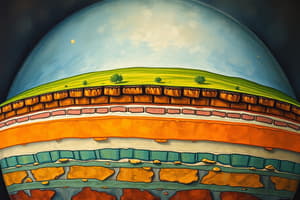Podcast
Questions and Answers
Match the layers of the Earth with their descriptions:
Match the layers of the Earth with their descriptions:
Crust = The outermost layer of the Earth Inner Core = The solid innermost part of the Earth Outer Core = The liquid layer surrounding the inner core Lower Mantle = The layer below the upper mantle that is solid
Match the Earth layers with their characteristics:
Match the Earth layers with their characteristics:
Continental Crust = Thicker and less dense than oceanic crust Oceanic Crust = Thinner and more dense than continental crust Upper Mantle = Part of the mantle that is semi-solid and allows for movement Asthenosphere = The region of the upper mantle that behaves like a viscous fluid
Match the terms with their roles in Earth's geology:
Match the terms with their roles in Earth's geology:
Convection Currents = Circulatory movement in the mantle that drives plate tectonics Middle Mantle = Also known as the transition zone between upper and lower mantle Crust = The layer where we live and has the continents and oceans Lower Mantle = Layer responsible for the flow of molten material
Match the layers with their composition:
Match the layers with their composition:
Match the layers of the Earth with their temperatures:
Match the layers of the Earth with their temperatures:
Flashcards are hidden until you start studying
Study Notes
Earth's Layers
-
Crust: The outermost layer of the Earth, composed of solid rock
- Continental Crust: Thicker, less dense, and older than oceanic crust. It makes up the continents
- Oceanic Crust: Thinner, denser, and younger than continental crust. It forms the ocean floor
-
Mantle: The thickest layer of the Earth, composed of hot, dense rock that flows slowly over time
- Upper Mantle: The uppermost layer of the mantle, includes the asthenosphere
- Middle Mantle: The middle layer of the mantle
- Lower Mantle: The deepest layer of the mantle, where the rock is very hot and under great pressure
-
Outer Core: A liquid layer of iron and nickel, generates Earth's magnetic field
-
Inner Core: A solid sphere of iron and nickel, extremely hot and under intense pressure
-
Asthenosphere: A partially-molten layer within the upper mantle, allowing tectonic plates to move
-
Convection Currents: Flows of heat within the mantle, caused by differences in temperature and density. These currents drive the movement of tectonic plates
Studying That Suits You
Use AI to generate personalized quizzes and flashcards to suit your learning preferences.




